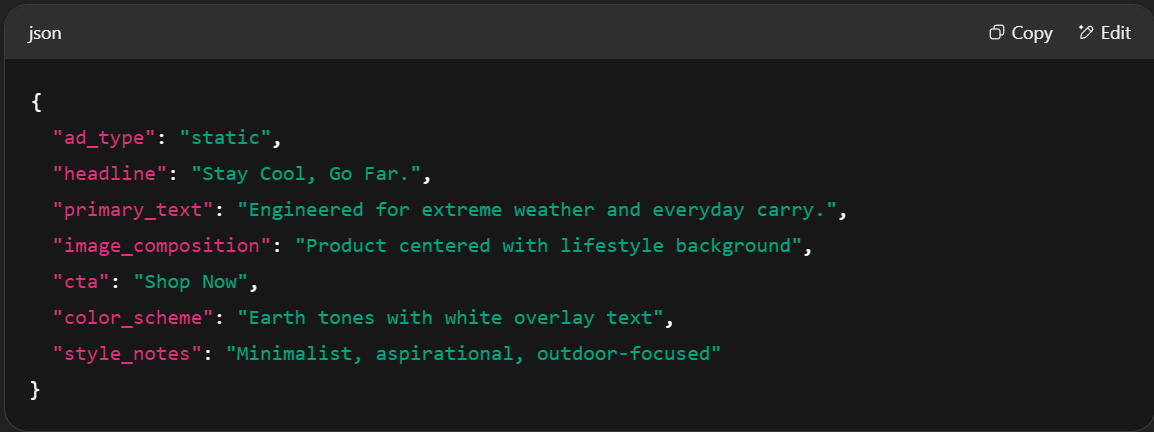By combining AI tools with structured analysis of top-performing ads, marketers can create personalized, scalable, and compelling creatives without needing a design team or production crew. This section explores how to reverse-engineer competitor ads, use ChatGPT to develop creative templates, and produce user-generated content (UGC)-style ads using AI avatars.
Reverse-Engineering Competitor Ads with Facebook Ads Library and ChatGPT
The Facebook Ads Library is one of the most powerful (and underutilized) tools for researching real-time ad trends. It provides full visibility into ads currently running across Meta platforms, including Instagram and Facebook, allowing you to analyze creative strategy, copy, format, and tone used by competitors or market leaders. But we can go a step further than simply reviewing the ads.
Users can upload screenshots or saved images of Facebook ads directly into ChatGPT and ask for a creative breakdown. ChatGPT will identify key structural elements from the image, such as:
Visual hierarchy (product placement, overlays, logos)
Copy tone and positioning
CTA style and formatting
Color palette and typography
Ad format cues (carousel, static, Reels preview, etc.)
From this, ChatGPT can generate a JSON-style creative template that defines the anatomy of the ad in a structured, repeatable format. This JSON output serves as a creative blueprint that helps you systematically generate new ad variants.
For example:
Once this template is generated, you can instruct ChatGPT to create original ad creatives for your brand using the same structure. This ensures your ads mirror the aesthetic and messaging tone of proven performers, without copying them outright.
Prompt Example:
“Generate 3 static ads for my eco-friendly backpack company using the JSON-style creative structure we derived from Patagonia’s ad.”
By standardizing creative styles this way, you build your own internal library of “ad archetypes” that scale easily across products and campaigns.
Creating UGC-Style Ads with AI Avatars
UGC, or user-generated content, continues to outperform polished studio ads across most Meta campaigns. These selfie-style videos, product reviews, or “day in the life” demos feel native to users’ feeds and carry higher trust and authenticity. But with AI, you no longer need to film real customers to create this content.
There are several popular AI platforms that let you create realistic avatar-based videos with just a script; perfect for scalable, UGC-inspired ad content:
1. Synthesia
Use case: Talking-head videos in selfie or studio style
Features: 100+ avatars, voice cloning, customizable backgrounds, gesture support
Pricing: Starts at $29/month for 10 minutes of video/month. Business plans offer white-labeling and collaboration tools.
2. HeyGen
Use case: Dynamic avatars with lip-sync and emotion; strong for casual, TikTok-style delivery
Features: Dozens of avatars with age, race, and gender diversity; direct scene editing
Pricing: Starts at $24/month for 10 minutes of video; bulk credits reduce cost per minute.
3. D-ID
Use case: Lifelike face animations; perfect for testimonials, reactions, or story-driven ads
Features: Upload your own photo or choose avatars; syncs with any script
Pricing: Freemium tier available; paid plans from $5–$49/month depending on usage.
4. Deepbrain.io
Use case: Corporate-looking presenters for training and DTC-style product explainers
Features: Custom avatars, multi-language support, green screen options
Pricing: Starts at $30/month with scalable minute-based plans.
How to Use These Tools in UGC Ad Creation
Start by reviewing UGC ads in your niche using the Facebook Ads Library. Look for structure, tone, pacing, and framing. Then, write a script that follows this same structure. Paste it into your AI avatar tool of choice, select a voice and look that matches your audience, and generate the video. Pair it with b-roll (stock footage of your product, lifestyle settings, or relevant cutaways), and you’ll have a high-performing, highly believable piece of content for Meta placements.
Pro tip: Consider matching the avatar’s appearance to your ideal customer persona. If your audience is primarily millennial moms, for example, select an avatar and delivery style that mirrors their language and energy.
When used together, Facebook Ads Library and AI content tools create a powerful feedback loop: research → reverse-engineering → creative templating → production. You no longer have to guess what kind of ad might work—just study what already does, extract the structure, and let AI do the heavy lifting to scale.

